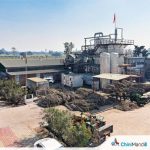The coronavirus pandemic has already affected the sugar industry by affecting demand, disturbing the supply chain and financially impacting the stakeholders. The industry is playing a waiting game to see how the movements in the world market would be.
In a recent interview with ChiniMandi News, Mr. Paul Steed – Sr. Global Price Risk Lead, Sugar at Mars Wrigley – World’s leading manufacturer of chocolate, chewing gum, mints and fruity confections shared his views on the global sugar market scenario.
Paul Steed’s sugar background spans physical trading, speculative position management and industrial sourcing. Paul joined Mars Wrigley in 2011 and is the Sr. Global Price Risk Lead. He drives sugar hedging strategies in all business units.
Paul is a past President of the Sugar Club and current member of the Board of the Sugar User’s Association. He also serves on the Agricultural Technical Advisory Committee for Sweeteners and Sweetener Products providing technical advice on agricultural trade issues to the Secretary of Agriculture and the United States Trade Representative. Paul is an active member of the Intercontinental Exchange’s No. 16 Sugar Contract Committee.
Speaking on how he sees the world sugar in flux and his forecast on the market movements he said, “On the macro-side, we have a recessionary event (the global pandemic) vs. a weaker USD and fears of future inflation. In sugar, we basically replaced ~6M MT of lost Thai production with ~10M MT of C/CS Brazil production. And specifically in the 4th quarter of 2020, we are replacing ~3M MT of Oct/Dec Thai exports with ~3M MT incremental stocks (compared to same time last year) in C/CS Brazil. The White Premium – especially during calendar Q3 – has shown how disruptive the loss of Thai availability has been for supply chains.”
Further adding his view on the market expectations in 2020-21 he shared, “It is very hard to see what will take us out of the 12 – 14 cent/lb. range basis ICE No. 11 futures (but something always does!). Sugar is stuck between the ethanol “soft floor” + ~1.5 c/lb. in Brazil and Indian export parity. Speculative investment in agricultural commodities is ~90% of the 2008 all-time high. Agricultural commodities are “cheap” relative to financial alternatives and might offer protection if we enter a cheap USD/higher inflation scenario. Sugar has a specific “bullish” story: it has been very dry in southern Brazil which may impact the next crop and El Ni/no conditions are forecast globally. Current sugar prices do not have much of a weather risk premium built into them. Any delay or reduction in India’s support for sugar would be a very bullish event.”
On being asked how he sees the future of the sugar industry evolving post covid-19 and what his views are on the production, consumption and export numbers with special emphasis on major producing countries Steed answered, “COVID 19 accelerated existing trends. For global agricultural supply chains, sustainability/human rights and health/wellness are in focus. In sugar, there will be a continued push to mechanize harvesting where possible, understand and map supply chains, and be able to convey a compelling sourcing story to consumers. Sustainability requirements and climate change should both make commodities more expensive to produce. Specifically in risk management, we expect the role played by artificial intelligence to continue increasing. According to CFTC data, automated trading systems account for 49% of grains and oilseeds volume, 54% of precious metals, 63% of crude oil and 82% in currency.”
“Coming to the second part of the question, global sugar demand has been decelerating for at least the past decade and COVID 19 will likely lower demand this year by 1 – 2%. We expect a modest (2 – 3M MT) surplus for 2020/2021. While European, Russian and Thai production is down a combined ~9M MT, Brazil, India and NAFTA (Canada, Mexico + USA) will produce almost 17M MT more.” He added.
Commenting on how he sees the world sugar consumption sheet take shape in the coming years, “We expect global consumption to grow below population growth rates. Industry is working to remove sugar from many products, several governments tax sugar consumption and health & wellness campaigns should work to lower per capita consumption. Global per capita consumption has been relatively stagnant just above 20 kgs for several years.
Global ethanol programs continue to be very important for sugar. At least an E10 program will have to play a role, if India is not to be a structural exporter after 2023. It is hard to see sugar prices much higher without the Brent oil price recovering back above USD50/barrel. Recovery in oil consumption back to pre-COVID levels of ~100M/day will likely not arrive until sometime in 2021.”
To Listen to this News click on the play button.











